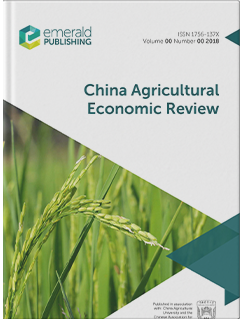中国玉米贮藏损失及其主要影响因素
IF 4.6
2区 经济学
Q1 AGRICULTURAL ECONOMICS & POLICY
引用次数: 3
摘要
目的本研究的目的是估计玉米在中国的储存损失,并对玉米储存损失的主要决定因素进行实证分析。基于对中国23个省(区、市)1196户家庭的全国性调查,作者估算了玉米的农场储存损失,并使用分数logit模型分析了中国玉米储存损失的主要决定因素。结果表明:①中国玉米贮藏期损失达1.78%,不同地区小农贮藏损失差异较大;(2)实证分析表明,库存量对库存量损失具有显著的负向影响,可能存在规模经济效应;储存用于消费和饲料的玉米比例对储存损失具有显著的积极影响,这可能与市场需求和管理活动有关。第三,与传统设施相比,筒仓和仓库的储存损失更低,而在储存阶段喷洒化学品和重新干燥玉米的损失更高,这可能是因为小农为了节省成本,只有在损失严重时才进行减损活动,而在采取措施时,农民可能会对粮食进行分拣,这也增加了损失。第四,在玉米成熟时收获与较低的储存损失显著相关。为了减少储存损失,首先,必须提高农民节约粮食和减少损失的意识。这可以通过有关节约粮食做法的农业培训和教育来实现。其次,政府可以提供补贴或低息信贷,鼓励农民使用先进设施,促进土地流转,实现规模经济。最后,政府应该加快智能农业系统的建设,及时监测作物生长情况,建议农民在适当的时候收获。减少收获后损失(PHL)已成为中国增加粮食供应和减少资源利用的重要手段。本研究全面介绍了家庭玉米储存损失情况,有助于表征中国粮食安全现状,这对粮食安全和粮食政策至关重要。本文章由计算机程序翻译,如有差异,请以英文原文为准。
Maize storage losses and its main determinants in China
PurposeThe purpose of this study was to estimate on-farm maize storage losses and to empirically analyse the main determinants of maize storage losses in China.Design/methodology/approachBased on a nationwide survey of 1,196 households in 23 provinces (autonomous regions and municipalities) in China, the authors estimated on-farm maize storage losses and used a fractional logit model to analyse the main determinants of maize storage losses in China.FindingsThe results showed that, first, 1.78% of maize was lost during the storage stage in China and that storage loss experienced by smallholders varied across regions. Second, the empirical analysis showed that storage quantities have significant and negative effects on storage losses and that an economy of scale in household storage may exist; the percentage of maize stored for consumption and feed has significant and positive effects on storage losses, which may be related to market requirements and management activities. Third, compared to traditional facilities, silos and warehouses cause lower storage losses, while spraying chemicals and re-drying maize in the storage stage incur higher losses, possibly because to save costs, smallholders conduct loss-reduction activities only when they suffer serious losses, and when taking measures, farmers may sort grains, which also increases losses. Fourth, harvesting maize when it matures is significantly associated with lower storage losses.Research limitations/implicationsTo reduce storage losses, first, farmers' awareness of food saving and loss reduction must be increased. This could be achieved through agricultural training and education regarding food-saving practices. Second, the government could provide subsidies or low-interest credits to encourage farmers to use advanced facilities and promote land transfers to realize economies of scale. Finally, the government should accelerate the construction of smart agriculture systems and the timely monitoring of crop growth to suggest farmers to harvest at the appropriate time.Originality/valueReducing post-harvest loss (PHL) has become an important means of increasing the food supply and reducing resources use in China. This study provides a complete introduction to household maize storage losses and can therefore help characterize the current state of PHL in China, which is of vital importance to food security and food policy.
求助全文
通过发布文献求助,成功后即可免费获取论文全文。
去求助
来源期刊

China Agricultural Economic Review
AGRICULTURAL ECONOMICS & POLICY-
CiteScore
9.80
自引率
5.90%
发文量
41
审稿时长
>12 weeks
期刊介绍:
Published in association with China Agricultural University and the Chinese Association for Agricultural Economics, China Agricultural Economic Review publishes academic writings by international scholars, and particularly encourages empirical work that can be replicated and extended by others; and research articles that employ econometric and statistical hypothesis testing, optimization and simulation models. The journal aims to publish research which can be applied to China’s agricultural and rural policy-making process, the development of the agricultural economics discipline and to developing countries hoping to learn from China’s agricultural and rural development.
 求助内容:
求助内容: 应助结果提醒方式:
应助结果提醒方式:


